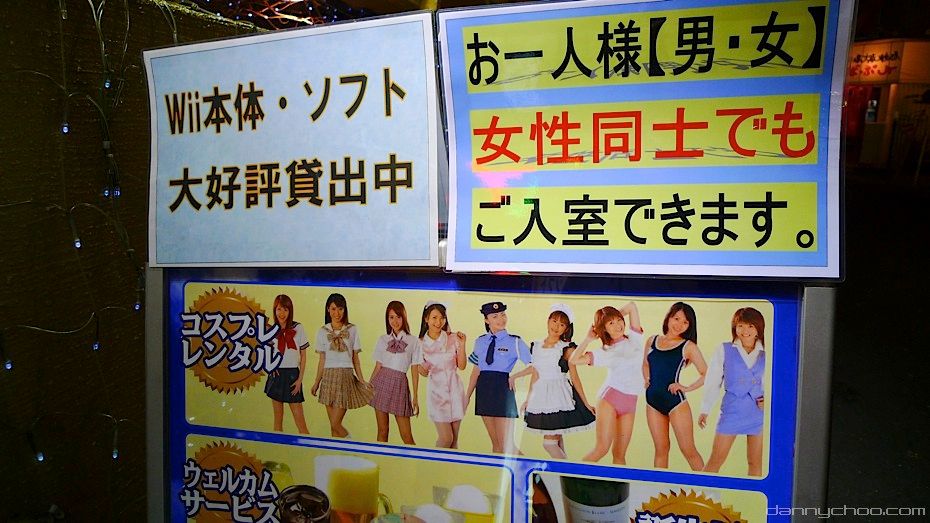Explore the depths of Shinjuku or Shibuya and you will come across love hotels - places designed for couples to have some hanky panky. Not only does this place allow female couples and folks on their own, they also rent out Wii and costumes for those who want some special hanky panky.
If you was to take a partner, which costume would you pick?
Japanese Love Hotels
Some history about the Japanese love hotel from Wikipedia below.
Love hotels developed from tea rooms chaya (茶屋), mostly used by prostitutes and their clients, but also by lovers. After World War II, the name tsurekomi yado (連れ込み宿), literally "bring-along inn" was adopted, originally for simple lodgings run by families with a few rooms to spare. These establishments appeared first around Ueno, Tokyo in part due to demand from Occupation forces, and boomed after 1958 when legal prostitution was abolished and the trade moved underground. The introduction of the automobile in the 1960s brought with it the "motel" and further spread the concept.
Love hotels developed from tea rooms chaya (茶屋), mostly used by prostitutes and their clients, but also by lovers. After World War II, the name tsurekomi yado (連れ込み宿), literally "bring-along inn" was adopted, originally for simple lodgings run by families with a few rooms to spare. These establishments appeared first around Ueno, Tokyo in part due to demand from Occupation forces, and boomed after 1958 when legal prostitution was abolished and the trade moved underground. The introduction of the automobile in the 1960s brought with it the "motel" and further spread the concept.
The original term has since fallen into disuse within the industry itself thanks to the euphemism treadmill, and an ever-changing palette of terms is used by hotel operators keen on representing themselves as more fashionable than the competition. Alternative names include "romance hotel", "fashion hotel", "leisure hotel", "amusement hotel", "couples hotel", and "boutique hotel".
Some more blurb about the hotels here below.
Love hotels can usually be identified using symbols such as hearts and the offer of a room rate for a "rest" (休憩, kyūkei?) as well as for an overnight stay. The period of a "rest" varies, typically ranging from one to three hours. Cheaper daytime off-peak rates are common. In general, reservations are not possible, leaving the hotel will forfeit access to the room, and overnight stay rates only become available after 10pm. These hotels may be used for prostitution or by budget-travellers sharing accommodation.
Love hotels can usually be identified using symbols such as hearts and the offer of a room rate for a "rest" (休憩, kyūkei?) as well as for an overnight stay. The period of a "rest" varies, typically ranging from one to three hours. Cheaper daytime off-peak rates are common. In general, reservations are not possible, leaving the hotel will forfeit access to the room, and overnight stay rates only become available after 10pm. These hotels may be used for prostitution or by budget-travellers sharing accommodation.
Entrances are discreet and interaction with staff is minimized, with rooms often selected from a panel of buttons and the bill settled by pneumatic tube, automatic cash machines, or a pair of hands behind a pane of frosted glass. Although cheaper hotels are often quite utilitarian, higher-end hotels may feature fanciful rooms decorated with anime characters, equipped with rotating beds, ceiling mirrors, or karaoke machines, strange lighting or styled similarly to dungeons, sometimes including S&M gear.
These hotels are typically either concentrated in city districts close to stations, near highways on the city outskirts, or in industrial districts. Love hotel architecture is sometimes garish, with buildings shaped like castles, boats or UFOs and lit with neon lighting. However, some more recent love hotels are very ordinary looking buildings, distinguished mainly by having small, covered, or even no windows.
And a video to boot - not sure how old it is though. Do they have stuff like this in your neck of the woods?
And a video to boot - not sure how old it is though. Do they have stuff like this in your neck of the woods?
